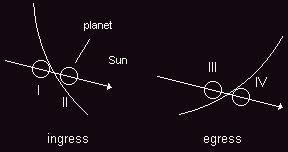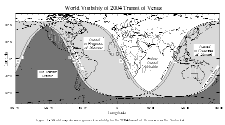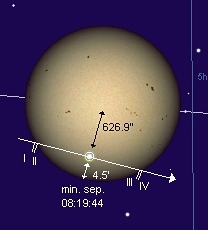|

- - text and links as of last publication - -
Venus Transit on June 8th, 2004
 A Rare Event A Rare Event
How Does a Transit Unfold?
2004 Transit Locations and Times
Observation Techniques
Observation Reports
On June 8th, 2004 a rare astronomical event occurs: Venus is transiting on Sun's disk. Last Venus transit occurred in 1882. As Venus transits occur by pair in a 8-year row, there will be another one in 2012 however. 2004 transit concerns Europe, Africa, and Asia. 2012 transit Pacific only (Alaska and Asia-Pacific). This series of transits is the 4th only since telescopic era began. So do not miss this transit if you are lucky enough to be in a zone where show is entirely visible. June, 8th is a Tuesday. For people out of where the show takes place, or in case of bad weather, sites are webcasting the event (see at page's end)
Venus transits are much rarer than Mercury's, and occur in pair about each century. This means that when about a century (precisely between 105 and 121 years) has elapsed, two Venus transits occur in a row, only separated by 8 years. This 2004 transit e.g.will be followed by another one in 2012 (June, 6th). But, after 2012, 105 years will elapse before any other transit. They will occur in 2117 (December, 11th) and 2125 only. Venus transits occur at nodes of Venus orbit and when the planet, at the same time, is at its inferior conjunction, that is when Venus passes where its orbit plane is intersecting Earth's orbit plane and when Venus, at the same time, is located between Sun and Earth. It it a these points and these moments that there is a chance that the planet be at direct Sun forefront as seen from Earth. Last transits occurred in 1631-1639, 1761-1769 and 1874-1882. A Venus transit is a rare event. Venus transits always occur in early June or early December, which is the time of Venus nodes crossing
Venus transits were major events until the 19th century as they allowed to accurately measure Sun-Earth distance. It was Edmund Halley who theoretically conceived such a project in the 17th century, assuming that a Venus transit, timed from widely separated locations, would allow this. An accurate Earth-Sun distance in turn was to allow measurement of solar system distances. And even distances to stars as stars are imperceptibly seen shifted from one point of Earth's orbit to another. If Earth's orbit diameter is known this allows to measure stars' distances! It was for the transits of 1761-1769 that the first expeditions were organized for the purpose of measuring Sun-Earth distance. The famed English explorer Cook -he was just a lieutenant at that epoch- led one of these expeditions in 1769. He settled in Tahiti island, now a French possession in the Pacific Ocean, as another expedition looked at the event since Hudson Bay, Canada. Today, such Venus transits are remaining useful as transits are part of methods used to detect exoplanets (planets which may exist about other stars), specially Earth-sized ones. A future NASA mission, Kepler, launching in October 2007, will look for such transit events and periodic brightness dips about 100,000 stars. Kepler craft is expected to detect about 50-60 exoplanets orbiting their star at about the same distance Earth is orbiting Sun
Technically a Venus transit unfolds like a Mercury's one or like a solar eclipse. In that sense, 2003 Mercury transit was a good rehearsal. Transiting planet is moving from the East to the West of the solar disk. Transit is divided into two ingress contacts (contact I and II), two egress contacts (III and IV) and a central point (it's the time of greatest transit; planet passes at nearest of Sun's center; this is also called "minimum separation"). Two ingress and egress contacts are understood like this: contact I is when planet's external limb arrives to contact with Sun's external limb. It's the external tangency. Contact IV, at the opposite, is the external tangency of planet's last external limb leaving Sun's limb. Contact II is the internal tangency: the planet having already progressed on the solar disk, its limb is leaving solar limb, and planet is beginning its course in front of the Sun. At the opposite, contact III is the internal tangency of planet beginning to definitively solar disk; as the planet is ending its transit, planet's limb arrives to contact of Sun's limb

Internal tangent contacts (II et III) are precisely the moments when, after or before the so-called "black drop effect", planet's disk is entirely encircled by Sun's light. Before, limbs are in contact. Planetary disk is not dissociated from Sun's limb. During 20 to 30 seconds, planet's dark disk is linked, drop-shaped, to solar limb. This is a natural optical effect which you can verify pinching your thumb and index fingers; just narrow both slowly and you will see, just before they touch, a shadowy bridge springing across the gap. It's a matter of dark-to-bright gradients. Contacts II and III are measured when planetary disk is completely dissociated (contact II) or when it stops being dissociated (contact III). It is these contacts which are usually measured. Contact I and IV are not easily observable as planet is still -or again- in Sun's glare. These contacts may be seen however using an H-alpha filter: planet is then seen silhouetting on prominences or Sun's chromosphere. Planet then crosses slowly the solar disk. This year, this will take 6 hours. Minimum separation is the center of the course: planet is at its nearest of solar disk's center, and farthest from the limb
2004 Venus transit is an European, African, and Asian one. Show will be entirely observable from start to end in Europe, Africa (except westernmost parts of it), and Asia (except Asia-Pacific). In  Americas, transit will be observable since sunrise only as it will have began before dawn, as southern South America (Chile) and all the western part of USA will be deprived of the event. In Asia-Pacific (Japan, eastern China, Australia) they will be able to see transit's beginning only as sunset will interrupt the show, and unluckily New Zealand is the "shadow zone" and is too deprived of the event. Alaska is OK, but not Hawai (except -and to be verified- westernmost part of the archipelago). For more details click on the map, courtesy of Fred Espenak, Eclipse Home Page. In 2012 South America will mainly be deprived of the show, like western parts of Africa; USA will have the show at sunset; Europe, Middle East, India, and eastern Africa will have it at sunrise Americas, transit will be observable since sunrise only as it will have began before dawn, as southern South America (Chile) and all the western part of USA will be deprived of the event. In Asia-Pacific (Japan, eastern China, Australia) they will be able to see transit's beginning only as sunset will interrupt the show, and unluckily New Zealand is the "shadow zone" and is too deprived of the event. Alaska is OK, but not Hawai (except -and to be verified- westernmost part of the archipelago). For more details click on the map, courtesy of Fred Espenak, Eclipse Home Page. In 2012 South America will mainly be deprived of the show, like western parts of Africa; USA will have the show at sunset; Europe, Middle East, India, and eastern Africa will have it at sunrise
Venus will take 6h 12 mn to cross solar disk. Minimum separation (distance between Venus and solar disk's center at the maximum of the transit) will be 626.9" i.e. about 10.5' or about two-third of solar radius. This means that transit's path is about one-third of a radius from the limb. Transit occurs in Sun southern part. First contact is at 116° and second at 119 (counterclockwise relative to  Sun celestial north pole). You will find below transit official UT times. Times may vary up to plus/minus 7 mn according to observer's locations. Some sites (like Sky and Telescope, or Fred Espenak Eclipse Home Page) give local times for various locations. For Paris times (local time) are: 7:20 a.m., 7:39 a.m., 10:22 a.m., 1:04 p.m., 1:23 p.m. (contact I and II, min. sep., contact III and IV) Sun celestial north pole). You will find below transit official UT times. Times may vary up to plus/minus 7 mn according to observer's locations. Some sites (like Sky and Telescope, or Fred Espenak Eclipse Home Page) give local times for various locations. For Paris times (local time) are: 7:20 a.m., 7:39 a.m., 10:22 a.m., 1:04 p.m., 1:23 p.m. (contact I and II, min. sep., contact III and IV)
| contact I | 05:13:29 | | contact II | 05:32:55 | | minimum separation | 08:19:44 | | contact III | 11:06:33 | | contact IV | 11:25:59 |
CAUTION! OBSERVING SUN IS DANGEROUS AND REQUIRES DEDICATED TECHNIQUES! As far as observation techniques are concerned, think first that observing the Sun is dangerous. About solar observation dangers, see the tutorial "Observing the Sun". Venus may theoretically be seen crossing the Sun naked-eye. Being about 1 arcminute, Venus will then look like a small sunspot. It is better to use binoculars or a small instrument at small power however. In both case use APPROPRIATE SAFE SOLAR OBSERVATION TECHNIQUES (see safe Sun observation techniques at tutorial "Observing the Sun"). If you observe naked-eye use appropriate filters (i.e. filters described as such and safe for naked-eye observing). If you use an instrument, either use projection technique -method by which the Sun's image is projected on a screen- or appropriate solar filters at instrument's aperture. If you are in a part of the Earth where Venus transit is visible at dawn or at sunset, you might be tempted to look directly at a low-hanging Sun. Don't. SUN IS DANGEROUS IN THIS CASE TOO!
Venus will be precisely 58" wide for this transit. Amateurs may make useful timing observations; see e.g. at the page Venus transit of the site Eclipse Home Page, by Fred Espenak
Like for any major astronomical event, the important is to get ready as such major events are breathtaking. Some days before the event, have a review of what is needed (depending on what kind of observation you will perform -visual, photographic, etc), think about where you will be observing from (for the transit, think of what Sun's course in the sky will be and imperatively choose a location where you will be able to see the entirety of the event), and precisely review the event timing. Try to visualise how the transit will unfold. Another major hint is to get comfortable (chair, sunglasses, hat, etc). And do not forget that you are going to see a very rare event. Since modern astronomy began, this is the fourth transit series occurring only!
->If you are not an amateur astronomy weathered observer, you might be surprised to see other dark features at Sun. Do not confuse them for other Venus planets. These are just sunspots, that is dark regions which are usually seen at Sun. Sunspost are part of Sun usual activity and are zones where solar surface temperature is lower than in surrounding regions, hence seen darker than them. Daily observation of solar sunspots may be an amateur astronomy activity. Note the difference. Venus is plainly round-shaped, sunspots are clearly irregular. On another hand, some observers, in four narrow 1-mile wide corridors, could unexpectedly see the International Space Station (ISS) swiftly transit the solar disk during Venus transit. more details at SpaceWeather.com
Would the weather be inclement, would you be in a part of the world where the transit is not observable, webcasts are forecasted. NASA partnered with the Exploratorium in Athens, Greece, to broadcast the event on the Internet. At SOHO, due to the craft orbit they won't see Venus transiting. The planet will just glide beneath the solar disk instead. Scientists will take advantage of Venus being visible against the emission of the diffuse corona to improve the quality of data gathered by SOHO as Venus transit will allow them to distinguish between light from the solar disk and light from the corona. Venus approaching-getting away from the Sun will be visible on the LASCO C3 field between June, 3rd-13th. A SOHO-related site will webcast the event (see at http://www.astronomy.no; a mirror site is to come shortly). TRACE spacecraft, which is another solar probe will, for its part, have the same perspective than Earth-located observers. Images and movies will be made available (see at http://vestige.lmsal.com/TRACE/transits/venus_2004/)
For any further details see at Eclipse Home Page, by Fred Espenak, which provides a wealth of data
Site's webmaster had the luck to be in France where the transit was entirely visible and to have a sunny weather all the way down.  | click to Venus seen on solar disk during June, 8th transit |
He did not see the beginning of the transit however as its observation material was not put into battery before about 9:30 a.m. French Time. Webmaster used projection method, projecting Sun's image on a screen through 8 x 12 binoculars. Transit was already in progress then and Venus was a striking, dark, and important point on the Sun. Contours were very well defined and Venus disk was a neat and black circle. Despite of the presence yesterday of a sunspot on the Sun, the Sun, for Venus transit seemed devoided of any sunspot. Transit unfolded very slowly giving a sense of perspective of the solar system and a sense of the speed of the planets on their orbits. Solar system is a very large place! The egress progress had the particularity of having Venus reaching the limb on a grazing trajectory and despite that to look like it was unfolding perpendicularly to the limb! A black drop effect seems to have been seen as Venus, generally speaking, was seen pear-shaped for a while about contact III. Venus disk then progressively exited the solar disk as its definitive exit was a strong moment, with Sun turbulences having a last indentation appear and disappear for a while. Venus is now continuing its way on its orbit. Next transit will occur in Pacific in 2012 as next transit twin series will be in 2117-2125 only. Venus transit was measured yielding a one-tenth of one percent decrease in solar output. Historical sunspots may go up to three-tenths. The Little Ice Age which plagued Europe about 1650 A.D. was probably triggered by such a three-tenths of a percent decrease, as Venus transit was the equivalent to all the energy used by humans in 2003. June, 8th 2004 transit picture © site 'Amateur Astronomy'
->Venus in SOHO LASCO C3
Venus transit may be reconstituted using SOHO solar craft LASCO C3 pictures. SOHO is a NASA/ESA spacecraft dedicated to solar science. Its LASCO C3 instrument is one of two  | | click to Venus in SOHO LASCO C3 coronograph, June, 3rd-12th |
coronographs, which are instruments blocking Sun light and allowing to study the corona, the outermost part of solar atmosphere. Although due to its orbit, SOHO could not see Venus transiting but passing just South of Sun instead, this pictures are a good account too of how Venus neared the Sun and got away. The planet may be seen dimming as it comes to its inferior conjunction, between the Sun and us, then increasing in brightness as it continues its path. This is due to Venus "last" and "first crescent" progressively disappearing and reappearing. Sun diameter is the central white circle. Blue circle and dark pole are parts of the coronograph. White line surrounding Venus are due to planet's overbrightness which is overexposing craft's CCD as the other bright spot, right, is Mercury. picture © site 'Amateur Astronomy', based on pictures courtesy Soho LASCO C3 daily picture, SOHO (ESA/NASA)
Website Manager: G. Guichard, site 'Amateur Astronomy,' http://stars5.netfirms.com. Page Editor: G. Guichard. last
edited: 12/28/2010. contact us at ggwebsites@outlook.com
|
 Observation Techniques
Observation Techniques Observation Reports
Observation Reports



 Sun celestial north pole). You will find below transit official UT times. Times may vary up to plus/minus 7 mn according to observer's locations. Some sites (like
Sun celestial north pole). You will find below transit official UT times. Times may vary up to plus/minus 7 mn according to observer's locations. Some sites (like 